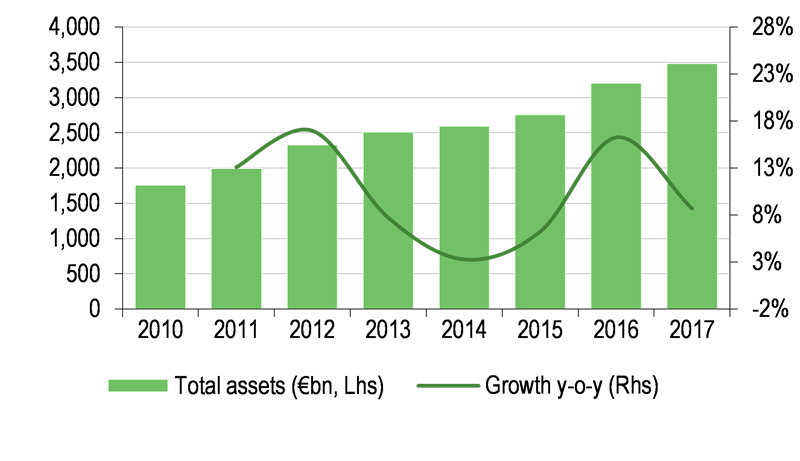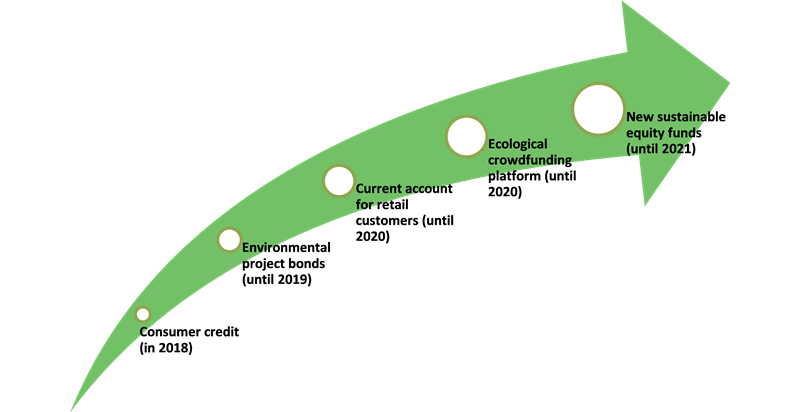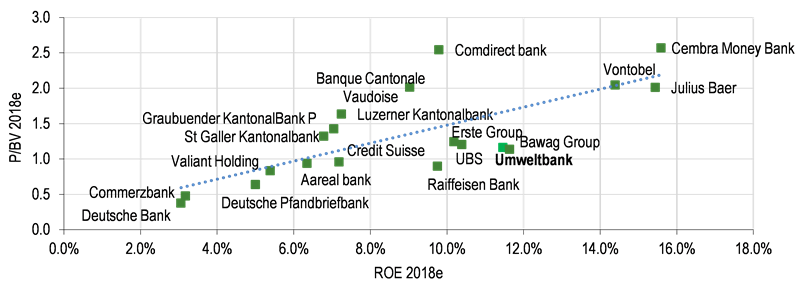UBK is a German direct and advisory bank headquartered in Nuremberg, specialising in financing ‘green’ projects in the areas of sustainable construction and RE, in particular solar and wind power projects. UBK is also active in the securities business, offering green stocks, environmental funds (managed by Ökoworld, SEB and JSS) and green project bonds, with a total value of funds invested by customers at more than €500m (as at end December 2017). Furthermore, the bank is also involved in the distribution of green insurance products. UBK was founded in 1997 and has since provided funding to over 22,000 projects. It serves nearly 114,000 clients (almost exclusively in Germany) and has an asset base of c €3.5bn (as at end December 2017). UBK’s free float stands at 84.4%, with the remaining 15.6% stake currently held indirectly by the founder, Horst P Popp, and his family through UmweltVermögen Beteiligungs AG. However, the stake was recently sold to GLS Gemeinschaftsbank eG (one of UBK’s competitors), with the transaction being effective as at 2 July 2018.
UBK’s lending business can be divided into two main areas:
■
Renewable energy: UBK provides financing to RE projects, such as solar and wind parks, hydro power plants, combined heat and power generation facilities, as well as biomass projects. Loan value is usually in the low- to mid-double-digit euro range, although it is somewhat lower in the case of solar projects. The bank focuses exclusively on solar systems larger than 250 kilowatts peak (kWp), but has an outstanding loan portfolio of smaller projects of around €110m. UBK is also funding repowering projects, although they constitute a minor part of the bank’s business.
■
Green construction: the bank also specialises in funding the new construction or renovation of sustainable residential housing for rental purposes, ownership housing, as well as community and commercial projects. The interest rate on the loans is dependent on the ecological quality of the project, in particular the energy savings associated with the utilisation of sustainable building materials increasing the energy efficiency of the building, as well as deployment of RE sources, eg rooftop photovoltaic (PV) systems.
At end 2017, UBK’s credit portfolio (including outstanding commitments) amounted to €2.62bn and was divided into green construction (35%), solar power (36%), wind and hydro power (25%), as well as biomass projects (4%, see Exhibit 1). Over the last five years, the portfolio structure changed noticeably, with a declining share of solar projects (which stood at 45.9% at end 2012) and an increasing contribution of green construction (FY12: 31.2%), as well as wind and hydro projects (FY12: 17.0%, see Exhibit 2). This shift was the outcome of a significant reduction in PV feed-in tariffs for new installations (a drop by around two-thirds between 2011 and 2015), as well as the first introduction of an auction system for new solar projects (EEG 2014) and wind parks (EEG 2017). Between 2010 and 2017, outstanding loans (including commitments) to green construction projects grew at an 11.4% CAGR, while loans to RE projects increased by an 8.3% CAGR over the same period.
Exhibit 1: Credit portfolio at end 2017
|
Exhibit 2: Credit portfolio structure evolution
|

|

|
|
|
Source: UmweltBank, Edison Investment Research
|
Exhibit 1: Credit portfolio at end 2017
|

|
|
|
Exhibit 2: Credit portfolio structure evolution
|

|
Source: UmweltBank, Edison Investment Research
|
Apart from the lending business, UBK selectively acquires indirect (through its fully owned subsidiary UPG UmweltProjekt Beteiligungen) and direct equity interests in selected RE and green construction projects. As at end 2016, UBK held interests valued at €22.4m in several projects, including 45.8MW of wind park capacity, 7.0MWp of solar project capacity, 16,477sqm of residential properties and 1,722sqm of commercial space. The projects represent a much higher investment value than UBK’s interest, as they are highly leveraged and UBK holds only a part of the invested equity. These participations represented less than 1% of total assets at end 2016, but UBK intends to significantly expand this portfolio through UPG.
The environmental guarantee
UBK is emphasising the so-called ‘environmental guarantee’, ie the promise that customer savings will be used exclusively to fund sustainable projects. For this purpose, UBK has established an environmental board as an independent controlling body organised in a similar way to a supervisory board, which prepares and presents an annual report during the AGM and has the authority to evaluate the funding eligibility of the bank’s individual projects. UBK adheres to a set of positive criteria as well as exclusions. Positive criteria include RE generation, decentralised energy production, combined heat and power generation, recycling or pollutant reduction and elimination. Exclusion criteria cover large-scale power plants in particular (lignite- and coal-fired or nuclear energy), manufacturing and distribution of weapons and other military goods, non-adherence to environmental standards, socially intolerable projects (eg exploitation of children), genetic engineering in agriculture and unfair business practices (eg corruption or human rights abuse).
Long-term growth story, but with earnings pressure lately
UBK has been able to grow its asset base and credit business for customers (including lending commitments) at a CAGR of c 10% in 2010–2017, compared to an average asset base decline of c 1% pa in the aggregate German banking sector over the same period (based on Deutsche Bundesbank data). This reflects a broader global trend where sustainable banks outperformed universal banks in terms of loan portfolio (2006–2015 CAGR at 14% vs 6%) and deposit base growth (14% vs 8%), according to the Global Alliance for Banking on Values. This was driven by solid momentum in ‘green’ investments amid supportive government policies, coupled with increasing environmental awareness among banking clients. UBK’s main competitive advantages include a strong understanding of the sustainable building and RE sectors and good direct contact and longstanding relationships with customers (average time of banking relationship is eight years, with 37% of customers being with UBK for at least 10 years). Moreover, UBK is able to offer attractive lending conditions based on refinancing options on preferential terms provided by KfW and other public development banks. These are loans granted for selected purposes (including sustainable projects), where the attractive interest rate is passed to the final borrower.
However, UBK’s business experienced a decoupling of net profit from asset-base growth starting in FY16, which was a combination of persistent low interest rate environment impairing the bank’s net interest margin (which according to our estimates declined from 2.06% in FY15 to 1.61% in FY17) and an increase in personnel and other administrative expenses, translating into a CIR increase from 22.0% in FY15 to 29.4% in FY17. Still, UBK remains ahead of the broad banking sector in terms of profitability and cost effectiveness, with our estimate of pre-tax ROE in 2017 at c 20% (vs sector average at 6.0% in 2016) and CIR (<30%) well below sector average (73.3% in 2016). The latter is assisted by lack of an extensive network of branches (‘direkt bank’ model) as well as flat and simple organisational structures.
Exhibit 3: Total assets evolution
|
Exhibit 4: Net profit* and net interest margin
|

|

|
Source: UmweltBank, Edison Investment Research
|
Source: UmweltBank, Edison Investment Research. Note: *Before allocation of reserves pursuant to Section 340g of the Commercial Code.
|
Exhibit 3: Total assets evolution
|

|
Source: UmweltBank, Edison Investment Research
|
Exhibit 4: Net profit* and net interest margin
|

|
Source: UmweltBank, Edison Investment Research. Note: *Before allocation of reserves pursuant to Section 340g of the Commercial Code.
|
The ‘3P’ strategy: Products, processes and personnel
UBK has identified several key areas of improvement, including net interest margin enhancement, digitalisation, strengthening of existing client relationships and acquisition of new customers (particularly in the age group below 45 years old). The bank plans to achieve these goals through the implementation of its ‘3P’ strategy, which covers the strategic initiatives below. According to UBK’s management, these projects are characterised by low investment requirements (although no company guidance with respect to implementation costs is available).
■
New products: UBK plans to expand its product offering over the next four years, including the introduction of a sustainable consumer credit, environmental project bonds, a current account product, as well as an ecological crowdfunding platform and new sustainable investment funds.
•
Consumer credit: the product will be dedicated to funding environmentally friendly spending of retail customers, which may include house renovation aimed at increased energy efficiency (heating systems, rooftop PV panels, insulation, etc) and potentially the purchase of an electric car. It will differ from the bank’s green construction lending business as it will be characterised by lower single loan size and no collateral requirement. Still, the borrower will be obliged to provide the relevant documentation to prove they have used the loan proceeds for sustainable expenses. The rationale behind launching this higher-margin product is to provide some relief to UBK’s squeezed net interest margin and expand its customer base. Importantly, the introduction of sustainable consumer credit (which is scheduled before end 2018) will be accompanied by the implementation of a new digital loan processing software.
•
Environmental project bonds: until the end of 2019, UBK plans to execute a bond issuance by UPG, its fully owned subsidiary through which the bank holds indirect equity participations in RE and green construction projects. The purpose of the issuance is to provide additional external funding to UPG and thus boost UBK’s return on equity invested in its subsidiary.
•
UmweltBank-Girokonto: UBK intends to become the primary or first bank for its retail customers. However, to achieve this it needs to broaden its offering to include a current account. The launch of this product, which will be accessible through an online banking portal, is planned before the end of 2020.
•
Other products: UBK is also planning to launch an ecological crowdfunding platform (until end 2020), as well as new sustainable equity funds (until end 2021, although some expansion of UBK’s fund offering should already take place this year).
■
Process digitalisation: there are several digital projects in the pipeline, including an online account opening process, video identification, as well as a digital customer portal. In particular, UBK intends to invest strongly in digitalisation and automation to facilitate the introduction of the new consumer credit product.
■
Personnel expansion: UBK is expanding its team of credit experts, IT professionals, as well as securities specialists. This has already been partially reflected in the bank’s cost base in FY16 and FY17.
Exhibit 5: UmweltBank’s timelines for new products launch
|

|
|
|






















